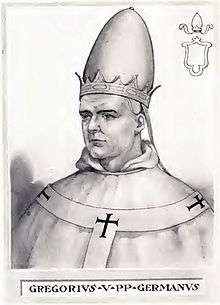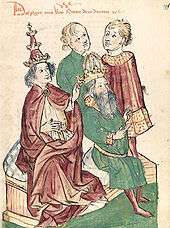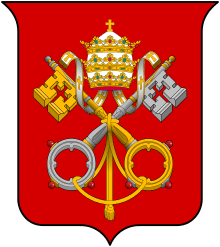Pope Gregory V
| Pope Gregory V | |
|---|---|
 | |
| Papacy began | 3 May 996 |
| Papacy ended | 18 February 999 |
| Predecessor | John XV |
| Successor | Sylvester II |
| Personal details | |
| Birth name | Bruno of Carinthia |
| Born |
c. 972 Duchy of Saxony(?), Germany, Holy Roman Empire |
| Died |
18 February 999 Rome, Papal States, Holy Roman Empire |
| Other popes named Gregory | |
Pope Gregory V, né Bruno of Carinthia (Latin: Gregorius V; c. 972 – 18 February 999) was Pope from 3 May 996 to his death in 999.
He was a son of the Salian Otto I, Duke of Carinthia, who was a grandson of Otto I, Holy Roman Emperor. Gregory V succeeded Pope John XV when only twenty-four years of age. He was the chaplain of his cousin Emperor Otto III, who presented him as candidate.
Gregory V was the first German Pope.[1] Sometimes Pope Boniface II (530–532) is considered the first German Pope, although he was in fact an Ostrogoth.

Politically, Gregory V acted consistently as the Emperor's representative in Rome and granted many exceptional privileges to monasteries within the Holy Roman Empire. One of his first acts was to crown Otto III Emperor on 21 May 996.[2] Together, they held a synod a few days after the coronation in which Arnulf, Archbishop of Reims, was ordered to be restored to his See of Reims, and Gerbert of Aurillac, the future Pope Sylvester II, was condemned as an intruder. Robert II of France, who had been insisting on his right to appoint bishops, was ultimately forced to back down, and ultimately also to put aside his wife Bertha, by the rigorous enforcement of a sentence of excommunication on the kingdom.[3]
Until the conclusion of the council of Pavia in 997, Gregory V had a rival in the person of the antipope John XVI (997–998), whom Crescentius II and the nobles of Rome had chosen against the will of the youthful Emperor Otto III, Gregory's cousin. The revolt of Crescentius II was decisively suppressed by the Emperor, who marched upon Rome. John XVI fled, and Crescentius II shut himself up in the Castel Sant'Angelo. The Emperor's troops pursued the antipope, captured him, cut off his nose and ears, cut out his tongue, blinded him, and publicly degraded him before Otto III and Gregory V.[4] He was sent to the monastery of Fulda in Germany, where he lived until 1013. The Castel Sant'Angelo was besieged, and when it was taken in 998, Crescentius II was hanged upon its walls.
Gregory V died suddenly, not without suspicion of foul play, on 18 February 999. He is buried in St. Peter's Basilica near Pope Pelagius I. His successor was Gerbert, who took the name Sylvester II.
See also
References
- ↑ Richard P. McBrien, Lives of the Popes: The Pontiffs from St. Peter to Benedict XVI, (HarperCollins Publishers, 2000), 138.
- ↑ Medieval Germany: An Encyclopedia, Ed. John M. Jeep, (Garland Publishing, Inc., 2001), 961.
- ↑ Eleanor Shipley Duckett, Death and Life in the Tenth Century, (University of Michigan Press, 1988), 130.
- ↑ The Papacy: An Encyclopedia, Ed. Philippe Levillain, (Routledge, 2002), 646.
-
 This article incorporates text from a publication now in the public domain: Chisholm, Hugh, ed. (1911). "Gregory V". Encyclopædia Britannica (11th ed.). Cambridge University Press.
This article incorporates text from a publication now in the public domain: Chisholm, Hugh, ed. (1911). "Gregory V". Encyclopædia Britannica (11th ed.). Cambridge University Press. -
 This article incorporates text from a publication now in the public domain: Herbermann, Charles, ed. (1913). "Pope Gregory V". Catholic Encyclopedia. New York: Robert Appleton.
This article incorporates text from a publication now in the public domain: Herbermann, Charles, ed. (1913). "Pope Gregory V". Catholic Encyclopedia. New York: Robert Appleton.
External links
| Wikimedia Commons has media related to Gregory V. |
- Kärnten, Brun von. In: Salvador Miranda: The Cardinals of the Holy Roman Church, online at fiu.edu, Website of Florida International University, retrieved 5 November 2011.
- Ein Salier auf dem Stuhl Petri, Online article on Gregory V, from the Diocese of Speyer's publication, Der Pilger
- "Gregorius V papa". Repertorium "Historical Sources of the German Middle Ages" (Geschichtsquellen des deutschen Mittelalters).
- Kärnten, Brun von. In: Salvador Miranda: The Cardinals of the Holy Roman Church, online at fiu.edu, Website of Florida International University, retrieved 5 November 2011.
- Ein Salier auf dem Stuhl Petri, online article about Gregory V, from the Diocese of Speyer's circular, Der Pilger
| Pope Gregory V Born: 972 Died: 999 | ||
| Catholic Church titles | ||
|---|---|---|
| Preceded by John XV |
Pope 996–999 |
Succeeded by Sylvester II |

